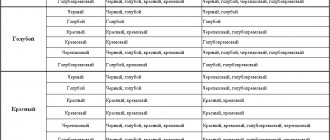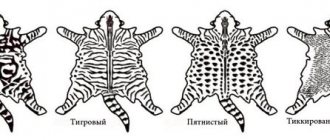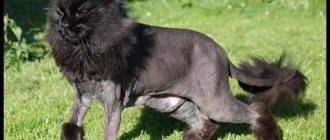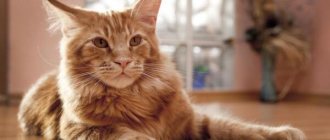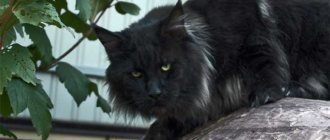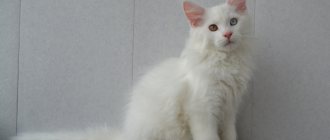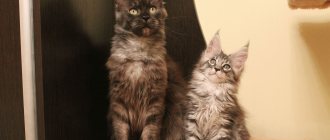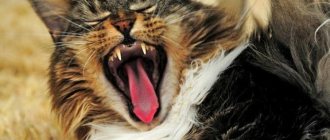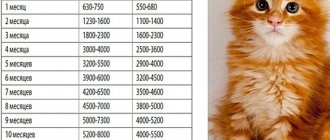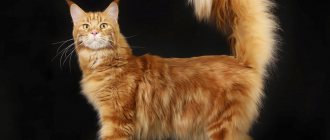From a genetic point of view, Maine Coons have two main coat colors – red and black. All other shades are different variations of the basic ones. All the variety of colors and patterns appears due to the special distribution of hair pigment, which determines the color of the animal.
Determining the hereditary color allows you to find out which cat's offspring will appear. Maine Coons are no exception here. To do this, breeders use special tables with formulas that will tell the color of future kittens. Based on them, you can decide how to cross the adults to get the desired result.
Maine Coons of different shades.
Traditional Maine Coon colors: photos and descriptions
There are several types of coat patterns called tabby.
They all have their own patterns. Tabby was inherited from the wild ancestors of modern domestic Maine Coons. Their distinctive feature is the letter “M”, which is visible in the area of the cat’s forehead and eyes with light or dark lines. There are three types of tabby:
- Tigers. The stripes on the body are parallel to each other.
- Spotted. There are spots of dark and light shades on the sides.
- Classic. Similar to the pattern of marble.
There is also a fourth type - ticked, but it is not typical for this breed. It is usually found in the Abyssinian breed and other oriental cats. It may appear in isolated coon individuals.
Often there are uniform colors in the same range; they are called solid or in the English version - solid (uniform). In this case, the tabby can be almost invisible. Often found in cats that are black in color. The darker the cat, the weaker the pattern of its coat appears. Tabby is especially pronounced in cats with fur of red (red) shades. Solids can be in the following palette:
- black;
- cream;
- red;
- smoky;
- blue.
Smoky gray and blue are of particular interest to Maine Coon breeders, as they are very rare for representatives of this breed. The gallery below shows photos of popular colors.
Maine Coon color calculator
To understand what color will result from crossing animals, breeders use a calculator table. With its help, you can predict with a very high probability what color the offspring of a thoroughbred couple will inherit.
How the coat colors of Maine Coon offspring interbreed.
This is, of course, not a guaranteed result, as it is impossible to calculate the exact genetic combination a kitten will inherit. From time to time, extremely interesting representatives of coons are born, having, for example, tortoiseshell tones, which is very rare for this breed. It has been noticed that most of these individuals are female.
Gray Maine Coon
Gray or blue colors are considered rare for this breed.
An even color of blue shades is a rare occurrence. A smoky shade is usually found. These cats look special; their color gives them their aristocratic charm. If a cat is exactly like this, it means that the gene responsible for the presence of a pattern on the body has been completely suppressed.
Blue tones are specially developed through selective breeding. This takes a lot of time and effort from breeders. The letter “A” is placed in the passport of such a kuna. If the cat has two-color fur, the code “03” is added to the letter designation.
Care and health depending on color
White coat color is recognized as the most dangerous in terms of cat health, which can give the Maine Coon not only charm, but also congenital deafness . By the way, Darwin once pointed out the connection between blue eyes, white color and deafness.
To minimize the risk of such an anomaly, many felinological organizations prohibit mating between two snow-white sires.
To avoid purchasing a deaf animal, you should not buy it through free classified sites or from dubious breeders. Remember that white kittens may have blurry markings on their faces; these usually go away with age.
It is better to wash white wool with special shampoos (for light-colored animals) and not to use conditioners that can give it an unnatural shade.
Owners of black Maine Coons face another type of difficulty - browning and graying of the coat. This usually happens before seasonal molting or, conversely, after a coat change. If your cat does not show off at shows, a change in shade is not fatal.
A Maine Coon vying for the championship title must be flawless - without a “collar” and “pants” that are gray or brown. Proper nutrition, as well as bathing and combing, which stimulate the removal of brown/gray hairs and the active growth of new ones, which eventually acquire a charcoal color, will help get rid of the unwanted shade.
Important! Black kittens are not always born from a pair of completely black Maine Coons. Sometimes a cat brings a litter with babies decorated with white spots in the groin or on the chest.
Return to content
The rarest and most expensive Maine Coon colors
Each breed has rare colors that are not often seen. Maine Coons are no exception. This breed has its own rare shades:
- Brown with spots. These kittens have a color similar to autumn foliage.
- Creamy blue. Looks like tortoiseshell with rare pastel shades.
- Chintz. This is a unique coloring for coons. The base is red, diluted with black tones with white splashes.
- Watered down chintz. There are cream-colored spots on a white background, and blue colors have a solid coloring.
- Spotted with white spots.
Such colors are not typical for coons and are rare.
Smoky
Such cats can be black or blue. The intensity of the haze determines the subspecies:
| Name | Description |
| Chinchilla | Only the tip of the hair is pigmented |
| Shaded | color has a quarter of the hair |
| Smoke | Only the root of the hair is colored white, the main part has black or blue pigments |
| True smoke | Half of the hair has pigmentation |
| Silver | the hair is white at the root, the rest is light silver |
| Cream | at birth, the coat is uniform in color, but gradually becomes unevenly pigmented |
| Classic wild | brindle, marbled black, spotted |
Smoky cats are characterized by white roots. Gray is usually found in monochromatic animals.
Chocolate
The wool is colored brown, warm, rich. The presence of inclusions of other shades or patterns is not allowed. The hairs have an even distribution of pigment. Unlike red tones, it is darker and deeper. Quite rare in breeding. The paw pads and nose also have brown tones.
Classic wild
This color suggests the presence of a pattern on the animal's fur. They can be of different types:
- brindle;
- marble black;
- spotted.
These are the main colors of coons that were common among their wild ancestors.
Peach
These cats have similar features to their cream counterparts. These can be yellow, orange shades characteristic of tabby coons.
Black
Black monochromatic coloring is extremely rare for this breed.
Each black coon has a different color depth and saturation, so it is impossible to find two identical black cats. Usually, this color hides the pattern on the coat. In small kittens it can be difficult to see, but as they grow older it is completely hidden. The cat becomes completely monochrome. An animal with black fur looks regal, luxurious, reminiscent of a majestic panther in appearance.
Black and white
Cats with this coloration have different proportions of these colors:
- Black with white spots. There are several small spots of white on the fur.
- White medallion. A white spot is located on the chest of the animal, reminiscent of decoration.
- White gloves. The cat has black and only white paws of the animal.
- White tuxedo. There is a white shirtfront on the neck, and the paws are also white.
- Bicolor. Black and white in a 1/1 ratio.
- Harlequin. The color is predominantly white with a few black spots.
- Wang. The head and tail are painted black. The rest of the body is white.
What is the danger of white color
White Coons have a predisposition to complete deafness.
It is found in this color much more often than in animals with a different shade of fur. However, there is no need to be upset by this fact. Deaf individuals feel great.
They live well in the house, and are oriented to the area no worse than healthy ones. Their hearing loss is compensated by vision and a keen sense of smell. People who do not know about cat deafness will not guess about it.
Cream
This shade is obtained by lightening the red. The animals are colored in shades similar to raw ginger. When crossing, individuals with genetically weakly expressed pigment in the pedigree are preferred. However, theoretically, even Black Solid Maine Coons can produce cream-colored offspring.
EMS code system
It was invented to make it easier for breeders and owners to navigate the smallest nuances of coloring, as well as for the convenience of judges evaluating Maine Coons.
The developed encoding consists of Latin letters and numbers, the combination of which determines the color of an individual individual. Each color has its own letter designation:
- N – black;
- D – red;
- E – cream
- W – white
- A – blue (lightened with N);
- F – tortoiseshell (found only in females);
- G – blue-cream (the result of tortoiseshell oxidation).
In addition, the Latin S appears in the name of the color if a silver tint is observed in the animal’s coat.
Important! The following colors not allowed by the standard are excluded from the EMS table: brown, lilac, fawn, chocolate, color-point (Siamese), gold and fawn (straw).
The presence of white color in wool is indicated by numbers: the larger they are, the higher the content of pigmented hair.
- 01 – white or almost white (with small spots on the head/shoulders or a colored tail).
- 02 – harlequin. Close to 01, but has more colored spots on the back;
- 03 – two-color, when half of the coat is bleached;
- 09 – white areas are insignificant and are located more often on the chest/paws.
Codes starting from the second ten describe patterned Maine Coons that meet strict breed standards.
- 21 - tabby (with its own letter designations). The pattern is smooth, clear and contrasts with the main color. The longer the hair, the more blurry and sloppy the tabby looks;
- 22 - marble, with round streaks on the sides. Two lines along the spine and a “butterfly” in the center of the shoulder blades are allowed;
- 23 - brindle (classic). Long clear lines encircling the sides, as well as one wide one along the ridge. If the stripes are intermittent, the pattern is called “mackerel”.
- 24 - spotted, with “mackerel” coloring on the front part of the body and noticeable spotting (“peas”) on the back;
- 25 - ticked, the rarest color option for Maine Coons with the complete absence of tabby.
Thanks to EMS encoding, it is easy and accurate to create a description of any cat, which fits perfectly into official documents, including certificates, veterinary passports and pedigrees.
Return to content
Tortoiseshell
The tortoiseshell Maine Coon comes in two types – torby and torty.
The first type is a combination of red and black shades of wool, expressed in a dark brown color. The torti has a greater addition of red with dark cream. Of particular interest is the fact that tortoiseshell coloring is most often found in cats.
The probability of a male being born with this coloring is approximately 1 in 1000.
On such cats, markings of different sizes and shapes are more clearly visible. Based on the severity of these spots, several colors can be distinguished:
- calico;
- flap;
- chintz.
These cats are characterized by the presence of red shades of fur. The classic color, consisting of three colors, is obtained by mixing black and red. This makes the coat more variegated. There are also several tortoiseshell shades.
Scaly tortoiseshell
Reminiscent of fish scales, the order of spots on the body is checkerboard. These spots alternate in black and red tones and are unevenly distributed. Any one of the colors may predominate.
Calico and solid tortoiseshell (patchwork)
The spots of black and red color resemble flaps. They have defined boundaries and can overlap each other. If the wool has white patches, this color is called “tortoiseshell white” or calico. Red and black spots are solid in color and clearly visible on the animal’s body.
Patterned tortoiseshell
Multi-colored spots have a pronounced pattern. These may be spots or stripes, but marbled colors are also common. There may be small white spots. In this case, it is fashionable to say that the color is spotted tabby or tabby with white spots.
Solid colors
Solid Maine Coons are the result of the successful work of professional breeders. This type of color is called just one word “solid”.
The color of almost every animal of this type will, upon careful examination, have vague hints of stripes; it can appear like a shadow. But the main impression is a single color. Depending on the shade, these stripes appear brighter or paler. It's almost impossible to compare stripes in bright red and cream. The stripes appear least in white cats, although at the age of kittens the pattern on their heads is still visible, but becomes more blurred with age.
Marble colors
Can be cold or warm tones. The first has more gray tones, while the warm one is dominated by brown shades. These stains sparkle in the sun in a special way, which many people like. Such stains can be drawn in different ways - stripes, spots, contours. Such spots can be well defined, then they are more reminiscent of a tortoiseshell color. Marble coloring has more diffuse, blurred borders of spots.
Tabby
This type of coloring is present in all representatives of the Maine Coon breed, but may not be expressed in a bright form. This color is a genetic predisposition. A cat's hair has its own zoning or striping. The wild ancestors were tabbies, which was inherited by modern representatives. There are various options for this design.
Classic, spotted and brindle tabby
Characterized by wide stripes of a spiral shape. They are usually located on the sides of the animal, and can resemble marble stains. Spotted tabbies have intermittent stripes or spots of color throughout the animal's body. The brindle tabby is similar to the brindle coloring - vertical stripes along the entire length of the body.
Ticked Tabby
These cats have no stripes or spots at all. The fur has a peculiar pattern on the face, paws, and chest. Ticking is the distribution of pigment along the hair. The tip has a rich shade, gradually losing brightness towards its root.
Silver and smoky colors
These colors of Maine Coon cats look especially beautiful and impressive. The base of each cat hair is white and the tip has pigment.
There is a regular smoky shade, “shaded smoke” and “chinchilla”. Silver cats can have beautiful green eyes.
The most valuable of the smoky cats are those with the colors “marble and silver”.
Their fur has a beautiful spiral pattern, similar to marble. Peach cats have white hairs at the base and a reddish tip.
Silver color in a Maine Coon/Yandex Collections
Random color combination
Sometimes there are situations when the maine has a color that does not fit any of the color types. For this purpose, its own classification was created. These colors can be called:
- Brown tabby with spots. Such an animal has spots of red and brown.
- Blue spotted tabby. The cat in this case has cream and blue stripes on its body.
- Creamy blue. The spots are scattered in a chaotic manner throughout the body. This color is sometimes called a blue turtle.
- Creamy blue, white.
- Spotted tabby with white spots. The color is similar to the previous one, but there are inclusions of white spots.
Such combinations are also rare.
With white markings
White markings, clearly defined (as opposed to the shaded spots of the Siamese) can be present on any color. You just need to add “With white (and white)” to the description of the main color. So, for example, you get “Black and White” or “Cream and White”.
The white areas may vary in size and location, and the most accurate name for the color depends on this:
With white medallion (locket)
- There is a white spot on the chest.
With white gloves (mitted)
– white slippers on the paws.
With white buttons
– the presence of one or more small white spots.
Bicolor (bi-color)
– half white.
Harlequin
- white with several large colored spots.
Van
- all white with color on the tail and head.
Tuxedo (tuxedo)
- white paws and chest. May have some white on head. This definition is informal.
Van
Harlequin
Bi-color
Tuxedo (Tuxedo)
With white medallion (Locket)
With white gloves (Mitted)
Unrecognized
Chocolate, gold, and lilac colors are not allowed at specialized exhibitions. Coons with Siamese coat color are also not recognized. There are patterns that are considered unrecognized for the Coons. These can be called:
- faun;
- cinnamon;
- point;
- sorrel;
- acromelanic color.
The coat color of Maine Coons is distinguished by a huge variety of colors and their combinations. The eyes of purebred animals must match the color of their fur. They can be blue (only pure white wool), green, yellow. White individuals may have different colored eyes (blue and green).
Character and habits
The Maine Coon is traditionally considered a very affectionate, safe and sociable cat that is devoted to its owner.
At the same time, this breed is constantly found in reviews of the most aggressive cats, although there is no objective information about attacks on owners. Obviously, the giant cats were victims of their terrifying appearance. Their length reaches 120 cm, their weight often approaches 15 kg (especially in sterilized cats), and a predatory, wary look and overgrown ears complete the portrait. It’s not hard to imagine how such a formidable cat sits on a tree and watches its prey.
But Maine Coon owners share their observations about the relationship between character and coat color. They believe that the red Maine Coon cat is distinguished from other animals by its incredible activity and curiosity. Of course, scientists confirm no connection between color and behavior, but practical examples often outstrip scientific conclusions.
This is interesting! If ginger cats live in the same house with kittens, they become caring fathers and devote a lot of time to their offspring, sometimes even more than the mother cat.
EMS color code
The International Association of Felinologists has developed a table that includes color options recognized by professional breeders. We need such a systematic collection for the convenience of making entries in the pedigree of the animal, bringing information about the breed to a single standard.
Unified table of coat colors according to EMS coding.
Thus, all colors not included in the standard coding are considered coat color defects. Individuals with unrecognized colors are not allowed at exhibitions and are not used in breeding.
However, they are suitable for home keeping in the same way as those with coat colors included in the table. Representatives of this breed have many genetically determined color options. Each Maine Coon is beautiful in its own way, no matter what color nature gave it.
Origin story
The history of the origin of all native cat breeds, including the giant Maine Coons, is shrouded in legends and myths.
The first hypothesis about how this breed appeared dates back to the times of the Vikings, when they conquered new lands. In the year 1000, warriors traveled on their boats to the New World, and with them the ancestors of Norwegian forest cats got there. However, the Vikings were soon forced to return to the old continent. But the cats stayed for a long time, and as a result of crossing with local cats, the Maine Coon appeared.
The second version dates back to the time of the French Revolution, when Queen Marie Antoinette planned her escape from Paris (1793). She sent her cats to Captain Samuel Clough's sailing ship in advance. The couple of monarchs did not manage to leave France, but the animals safely reached the shores of the United States in Maine. There the cats received new blood from local animals, which became the basis for the formation of a new breed.
Another legend says that Maine Coons are the offspring of a domesticated cat and a wild Manx raccoon.
Objective data about Maine Coons appeared only at the beginning of the twentieth century, when “The Book of the Cat” by the American Frances Simpson was published in 1903. In it, the author described in detail both her own pets and the animals that belonged to her friends. The beginning of the story dates back to 1861, which became the main starting point in the biography of this extraordinary breed. Then there are almost no blank spots left in the Maine Coon chronicle:
- Beginning in 1860, Maine farmers exhibited local cats during the annual fair.
- Most of all, Maine Coons were valued not for their external qualities, but for their incomparable ability to hunt rodents - the large cat easily coped with the invasion of mice in grain barns.
- In 1895, 12 Maine Coons took part in the first national North American show - the cat Cozy from Maine was named the winner of this show.
Then history made an unpleasant zigzag - in the twentieth century, the large Maine Coon breed was almost destroyed by the expansion of the Persians and Turkish Angora cats. In 1911, the aborigines took a prize for the last time at an exhibition in Portland and disappeared from the field of view of felinologists for 40 years.
The big cats were rescued in the same place where their lineage began - in the agricultural regions of America. Farmers were indifferent to fashion trends, but they were concerned about the safety of the crop. So the Maine Coons did what they knew how to do best - catch rodents.
In 1976, the breed was completely restored, it returned to international exhibitions and from that time on never disappeared. Another 9 years later (1985), Maine Coons were recognized as the official state cat of Maine.
This is interesting! Red Maine Coons belong to the group of “talkative” cats. They masterfully control their voice and love to purr loudly, meow in every way, and sometimes even imitate the sounds of the surrounding nature.
